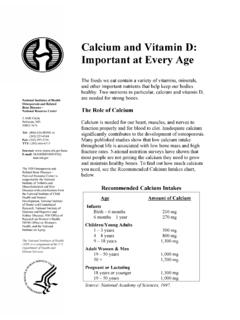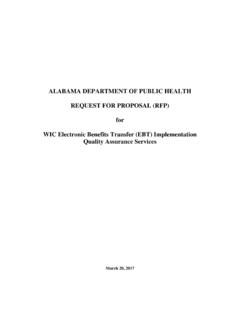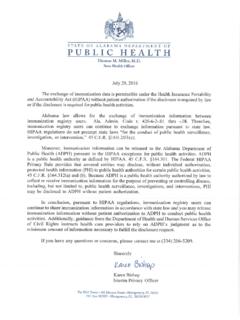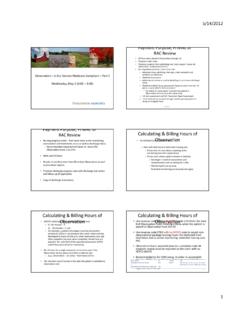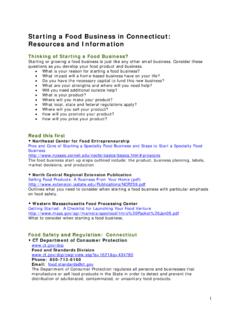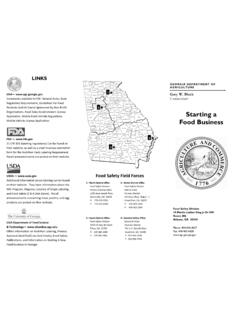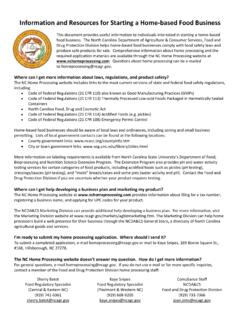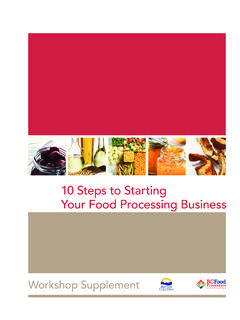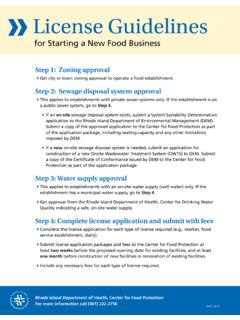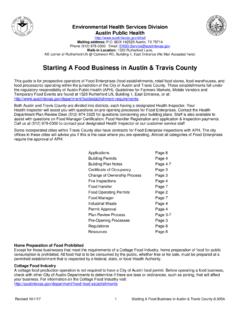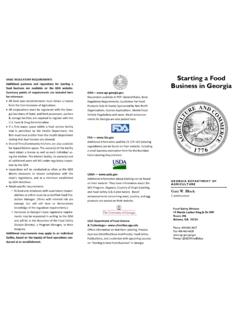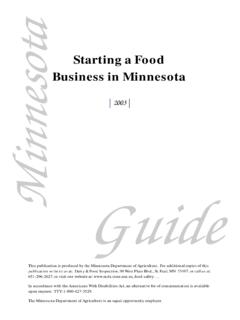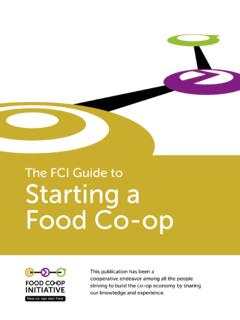Transcription of Starting A Restaurant - Alabama Department of Public Health
1 General Information on Starting a Restaurant business in Alabama This information is intended to give a general idea and overview of Health Department construction requirements for Starting a retail food business . The specific design or intended operation of an establishment may necessitate additional construction items;. some limited food establishments or operations may not require every item exactly as described here. Your County Health Department will work with you on the specific construction requirements for your establishment as governed by the Rules for food Establishment Sanitation.
2 PLANS. Floor plans are required to be reviewed and approved by the County Health Department prior to beginning construction. This will protect you from buying equipment or installing an item that does not meet County Health Department requirements. It is easy to correct problems on paper but can be very expensive to correct problems after construction and installation. Show the proposed location of all equipment, sinks, restrooms, storage areas and so forth. Include a site plan showing your entire lot, garbage storage area and any other significant items (for example, grease trap location).
3 Include a "finish schedule" of floor, wall and ceiling coverings and a list of the proposed equipment, as detailed as possible. NOTE: Check with your County Health Department about requirements for an architect's seal on plans. PLUMBING/WATER SUPPLY. Must be installed according to local Plumbing Code standards. Enough hot water for the intended operation must be provided. Water heaters must provide enough temperature rise to furnish hot water to all plumbing fixtures and allow for general cleaning. The Health Department or your local electric or gas utility can help you with the size of the water heater you need.
4 Provide a vacuum-breaker at each hose connection. Provide hot and cold tempered water to all sinks through a mixing valve. Provide indirect drains for all equipment requiring drainage (ice machine, dishwashers, etc.). The water supply must be from a source approved by the Health Department . 1. SEWAGE DISPOSAL: All sewage, including mop water and wastewater, must be disposed into a sanitary sewer or a Health Department -approved septic tank system. No sewage, including used grease, mop water or wastewater shall be deposited onto the ground or to any area accessible to insects or vermin.
5 The Health Department 's environmentalist can give you specific requirements for grease traps and septic tanks. (See EQUIPMENT for sink requirements). CONSTRUCTION. FLOORS ( food and utensil handling area, storage and toilet rooms): Constructed of durable, smooth, easily cleanable material such as sealed concrete, quarry, terrazzo or ceramic tile, durable grades of linoleum, vinyl tile and so forth. If water-flush (hose-down) cleaning is to be used, the floor must be constructed of a masonry or tile material, graded to drain and be coved and sealed at the floor-wall juncture.
6 Exposed horizontal utility lines and pipes on the floor are prohibited. WALLS AND CEILING: Constructed of smooth, durable material with a non-absorbent finish, well-lighted and light colored. No exposed studs, joists or rafters, no unnecessarily exposed utility service lines or pipes are allowed. No bare wood and no contact paper (including shelves) is allowed. DOORS: Doors to the outside are to be self-closing and tight fitting. RESTROOMS: Floors, walls and ceiling as described above. Doors are to be self-closing and solid construction. Covered waste cans are to be provided.
7 The rooms are to be power-vented to the outside. The number of restrooms must be that required by the local Plumbing Code, but at least one. GARBAGE: Outside garbage containers (including dumpsters) must be stored on a substantial pad of sealed concrete or machine-laid asphalt. 2. Provide hot water, and wastewater disposal facilities, for cleaning containers. Also check with local plumbing officials about water requirements. LIGHTING: At least 50 foot-candles of light on all food preparation surfaces, including cooking equipment. At least 20 foot-candles in all other areas.
8 The lights in food handling, food storage, and equipment cleaning/storage areas are to be shielded. VENTILATION: All rooms, including storage rooms, are to have sufficient ventilation to keep them free of excessive heat, steam, obnoxious odors, smoke and fumes. If greasy fumes or a water condensate problem are inherent in the cooking operation, the cooking equipment must be installed under a ventilation hood, with removable filters, power-vented to the outside. If a water condensate problem will be created with a mechanical dishwasher, it must be vented to the outside.
9 Pipes and conduits must be concealed within the hood structure except pipes for the fire extinguisher system. The hood and installation must be approved by the Fire Marshal where applicable. Check the list of other Agencies to Contact at the end of this pamphlet. LOCKERS/DRESSING ROOMS: Provide enough lockers or other suitable facilities to store employee clothing and other personal belongings (for example, purses). These facilities may be located only in designated rooms or areas containing only completely packaged food or completely packaged food -related articles.
10 If employees routinely change clothes within the establishment, rooms or areas must be designated for that purpose. These areas cannot be used for any part of the food -handling operation. STORAGE: Provide enough dry storage area for the intended operation. PREMISES: The walking and driving surface of the exterior area must be surfaced with concrete, asphalt, gravel or a similar material effectively treated to minimize dust. These surfaces must be graded to prevent water pooling. 3. EQUIPMENT. COOLING: Provide refrigeration adequate for the intended operation; capable of maintaining a product temperature of about 40F or below.
